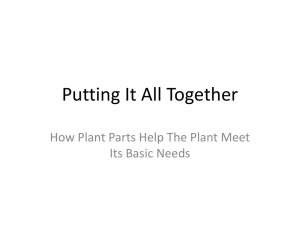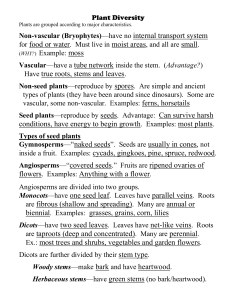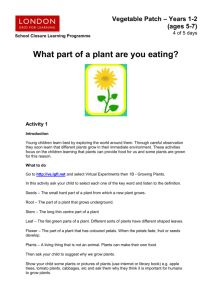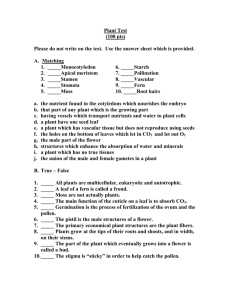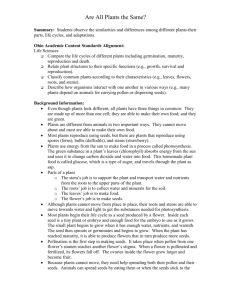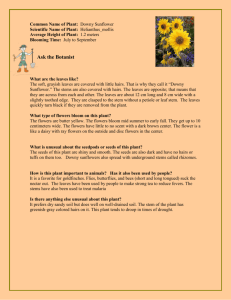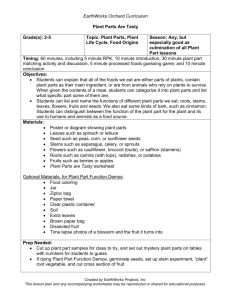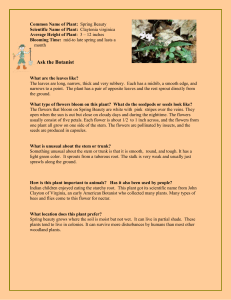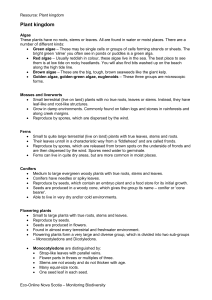Science of Life Explorations Plant Anatomy: Plants as Food
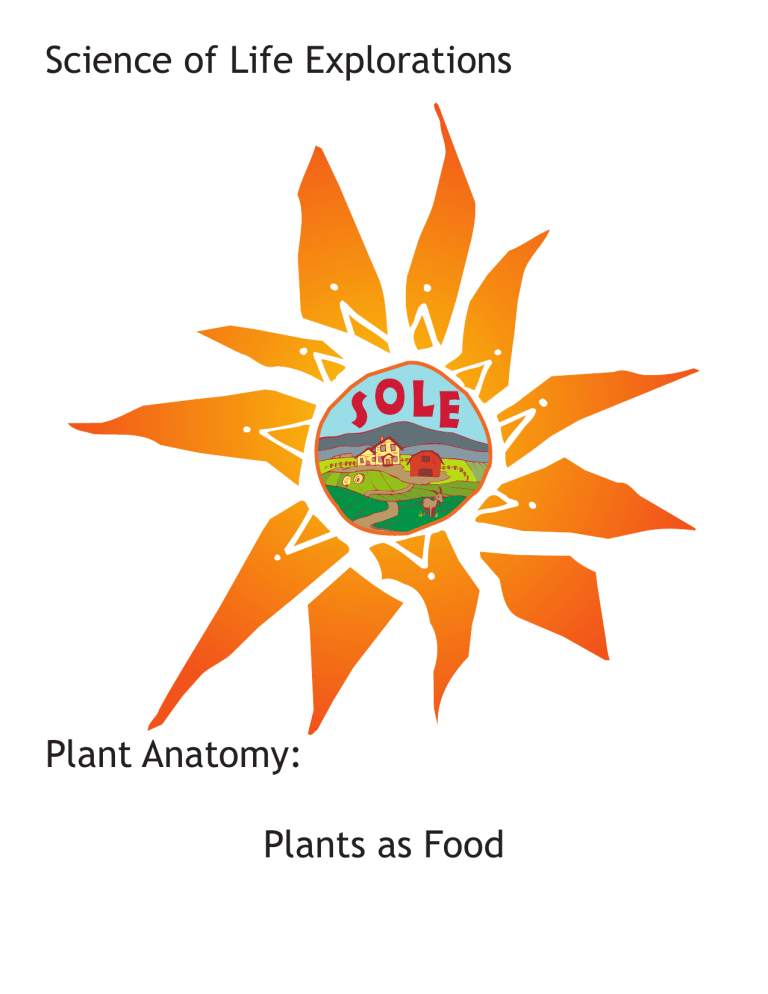
Science of Life Explorations
Plant Anatomy:
Plants as Food
Hungry? Eat a plant part!
Do you like your veggies? Are veggies the only type of plant we eat?
Think about this: do you like peanut butter and jelly sandwiches?
Peanut butter comes from peanuts, which come from a peanut plant. The peanut is the seed of the plant and grows underground! Because we learned that seeds store energy for the plant, we can understand that when we eat peanuts we are eating a good source of food energy.
Jelly comes from fruits and is made with sugar. Even sugar comes from a plant.
But it is a very different kind of food energy than a peanut.
What plant is the main ingredient in most breads?____________________
Some of our food comes from plants, and even food that isn’t directly from plants depends on plants (remember the food chain). If you eat meat, eggs or dairy products, you are depending on plants such as grains to feed the animals that produce those foods!
When you eat these foods, what part of the plant are you eating? As a class, place these foods into the categories listed: apples? asparagus? broccoli zucchini? onions? lettuce?
celery?
walnuts?
peas?
carrots,
Now, think of others not on our list. List other foods that are plant roots, stems, seeds, flowers or fruit.
plant roots: plant stems:
plant seeds plant flowers plant fruit plant leaves
We discussed the ingredients of a peanut better and jelly sandwich to show how plants are an important part of your diet, even if you don’t like your veggies.
Find a recipe. or interview a cook to learn the ingredients of something you like to eat. Write down the name of the meal or “dish” and list the plants used for that meal. Think carefully about whether the plants involved are used in the form of roots, stems, flowers, seeds, or stems! Ask an adult to help you.
Burrito:
Example: Bean Burrito with Salsa!
Beans - plant seeds
Lettuce - plant leaves
Onions - plant stem
Salsa:
Tomatoes - plant fruit containing seeds
Cilantro - plant leaf
Hot peppers - plant fruit containing seeds
Cheese - not a plant part, but came from a plant fed animal
Flour tortilla:
Wheat flour - wheat seed
Oil - pressed plant seeds or fruit
What plant parts are used in your favorite meal?
_____________________________________________________
___
__________________________________
__________________________________
__________________________________
__________________________________
__________________________________
_________________________________
__________________________________
__________________________________
__________________________________
_____________________________
__________________________________
Vocabulary anatomy - the science that deals with the structure of an animal or plant or one of its parts angiosperm - the scientific name for plants that produce flowers as part of their life cycle annual - plants that survive one growing season in a particular area broadleaf - the term for plants that have broad leaves rather than needles cambium- a layer of cells under bark and phloem; new cells are formed along this layer which cause the plant to grow larger each year carbon dioxide - a gas in our atmosphere that plants use to make their own food energy; animals exhale carbon dioxide into the air chloroplasts - an important part of plant cells that enables plants to create food energy for themselves in the process of photosynthesis circumference - the measurement of something all the way around it conifer - a term for plants that produce narrow needle-like leaves rather than broad leaves consumers - animals or people that acquire (eat, buy, take) products created by others cotyledon - the first and very important leaf or leaves of flowering plants crown - a tree crown is all the branches and leaves of the tree; a plant crown is the base of the plant at ground level, above the roots and the source of new leaf growth deciduous - the term for woody plants that drop their leaves before winter
dicot - the term for a flowering plant which produces two leaves on its shoot and will develop branches and leaves when mature dormant - for plants, this means active growth stops due to a change in season essential -something that is very important and needed estimate - a good guess or calculation of something based on the information you can gather about it evapo-transpiration - the way that plants release water back into the soil through their leaves; it is a form of evaporation when water changes into a vapor evergreen -the general term used for plants that don’t lose their leaves; most are conifers, but not all gymnosperm - the scientific name of plants that don’t produce flowers but create seed-bearing cones instead herbaceous - plants that do not produce a woody covering to their stems and generally die back in the winter monocot - plants that send up one shoot and one new leaf only, and will mature to have only one stem needles - the name for the narrow ‘needle-like’ leaves of conifers oxygen - the gas found in our atmosphere that animals must inhale to to nourish their cells and stay alive; plants release oxygen perennial - plants that complete a life cycle in one season and resume growth again for more than one year phloem - phloem is the part of plants that transports food energy from leaves down to the roots.
photosynthesis - the way plants create their own food energy protista - the scientific kingdom that includes fungi, molds, algae and other organisms shrub - similar to a tree but usually has more than one woody stem stem - the stalk or trunk of a plant; there can be one or many stems on a plant trait - a quality of or a feature of something that stays constant trunk - the woody stem of some plants, especially shrubs and trees turf - grass that is grown and maintained to be a lawn or outdoor use area unique - one of a kind; not like others vary - to show variety or differences vascular bundles - plant tissue that acts as waterways to move food energy, nutrients and water throughout the plant veins - tube-like structures which allow water and sugars to travel through plants or in the case of animals, blood to the heart woody - a plant that has bark over its stem rather than soft green tissue xylem - xylem is the part of a plant that transports water and nutrients up to leaves
For Teachers and Parents: Pg 1 How else do plants help us survive and thrive? In previous lessons, we have discussed how plants are the basis of most food chains. The next few pages show students how dependent we are on plants for our food. Ask students if they eat a lot of plants. Their first response will likely be “no” until they start to consider what foods they eat in the course of a day. Does everything come directly from plants? Of course not. The obvious examples are meat and dairy products. When students consider the food chain involved in meat and dairy products, they will see that plants are the basis of most of their food.
Pg 2 Fruit or vegetable? A fruit is the part of a plant that contains seeds. This makes sense when we talk about fruits like apples and pears. But what about green peppers and tomatoes? Vegetables are what we call the other edible parts of plants that do not contain seeds. This can be very confusing! We don’t expect to see fruit salads contain cucumbers, do we?
When we eat a variety of fruits and vegetables, we don’t think about the legalities of the science of the plant. When students suggest some of the edible plants above and others, it can be an interesting assignment to further research this subject.
Pg 4 Writing Activity: This activity is a good research project to incorporate adults in the home, or volunteers in the school. Students can partner and choose a favorite dish or meal to investigate. First, they will list some or all of the ingredients. Then, they will determine the source of that item.
Some of our food comes from plants, and even food that isn’t directly from plants depends on plants (remember the food chain). If you eat meat, eggs or dairy products, you are depending on plants such as grains to feed the animals that produce those foods!
When you eat these foods, what part of the plant are you eating? As a class, place these foods into the categories listed: apples? asparagus? broccoli zucchini? onions? lettuce?
celery?
walnuts?
peas?
carrots,
Now, think of others not on our list. List other foods that are plant roots, stems, seeds, flowers or fruit.
plant roots: carrots beets turnips plant stems: asparagus onions celery onions
FYI: potatoes and onions are not actually true roots but a form of modified stem.
(however they are often called root vegetables)
plant seeds apples zucchini tomato cucumbers strawberries plant flowers broccoli cauliflower plant fruit walnuts peas beans sunflower seeds plant leaves lettuce kale spinach cabbage
